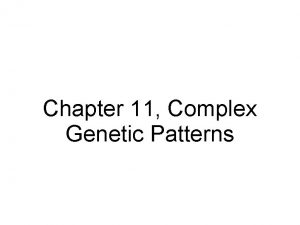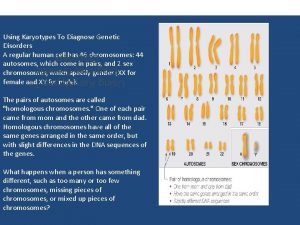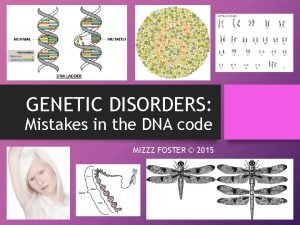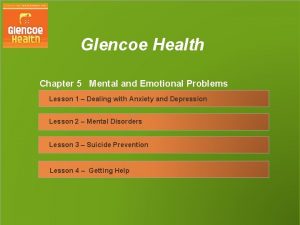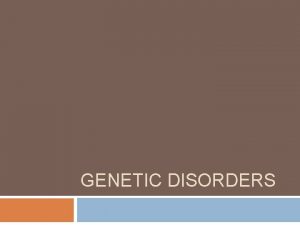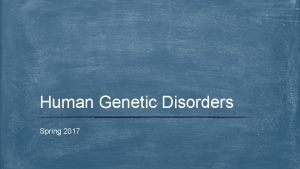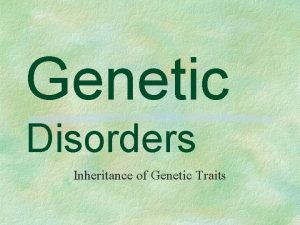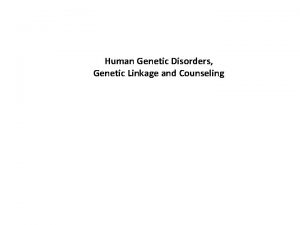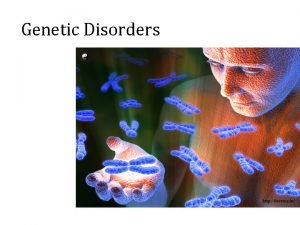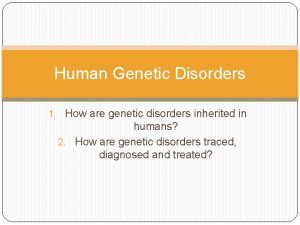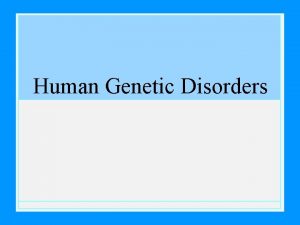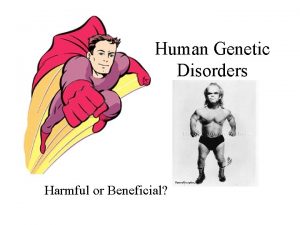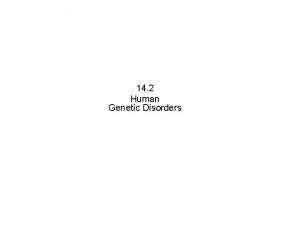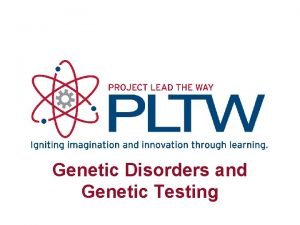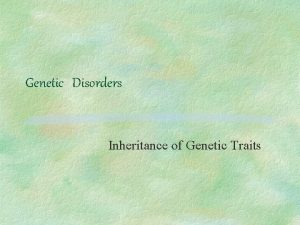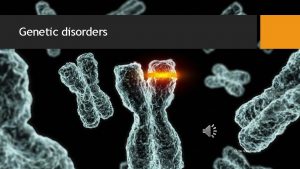Lesson Overview Human Genetic Disorders Lesson Overview 14















- Slides: 15

Lesson Overview Human Genetic Disorders Lesson Overview 14. 2 Human Genetic Disorders

Lesson Overview Human Genetic Disorders From Molecule to Phenotype How do small changes in DNA molecules affect human traits? Changes in a gene’s DNA sequence will change the amino acid sequence that codes for the production of a protein. Altering the protein production, can directly affect one’s phenotype.

Lesson Overview Human Genetic Disorders From Molecule to Phenotype Molecular research techniques have shown a direct link between genotype and phenotype. For example, people of African and European ancestry are more likely to have wet earwax—the dominant form. Those of Asian or Native American ancestry most often have the dry form, which is recessive. A single DNA base change from guanine (G) to adenine (A) in the gene for a membrane-transport protein causes this protein to produce dry earwax instead of wet earwax.

Lesson Overview Human Genetic Disorders Sickle Cell Disease This disorder is caused by a defective allele for beta-globin, in hemoglobin, the oxygen-carrying protein in red blood cells.

Lesson Overview Human Genetic Disorders Sickle Cell Disease Sickle-shaped cells are more rigid than normal red blood cells, and they tend to get stuck in the capillaries. If the blood stops moving through the capillaries, damage to cells, tissues, and even organs can result.

Lesson Overview Human Genetic Disorders Cystic Fibrosis Cystic fibrosis (CF) is most common among people of European ancestry. Most cases result from the deletion of just three bases in the gene for a protein called cystic fibrosis transmembrane conductance regulator (CFTR). As a result, the amino acid phenylalanine is missing from the protein.

Lesson Overview Human Genetic Disorders Cystic Fibrosis With cell membranes unable to transport chloride ions, tissues throughout the body malfunction. Children with CF have serious digestive problems and produce thick, heavy mucus that clogs their lungs and breathing passageways.

Lesson Overview Human Genetic Disorders Huntington’s Disease Huntington’s disease is caused by a dominant allele for a protein found in brain cells. The allele for this disease contains a long string of bases in which the codon CAG—coding for the amino acid glutamine —repeats over and over again, more than 40 times. The symptoms of Huntington’s disease, namely mental deterioration and uncontrollable movements, usually do not appear until middle age. The greater the number of codon repeats, the earlier the disease appears, and the more severe are its symptoms.

Lesson Overview Human Genetic Disorders Genetic Advantages Disorders such as sickle cell disease and CF are still common in human populations. Why are these alleles still around if they can be fatal for those who carry them?

Lesson Overview Human Genetic Disorders Individuals with just one copy of the sickle cell allele are generally healthy, and are also highly resistant to the parasite, giving them a great advantage against malaria. Genetic Advantages

Lesson Overview Human Genetic Disorders Genetic Advantages More than 1000 years ago, the cities of medieval Europe were ravaged by epidemics of typhoid fever. Typhoid is caused by a bacterium that enters the body through cells in the digestive system. The protein produced by the CF allele helps block the entry of this bacterium. Individuals heterozygous for CF would have had an advantage when living in cities with poor sanitation and polluted water, and— because they also carried a normal allele—these individuals would not have suffered from cystic fibrosis.

Lesson Overview Human Genetic Disorders Chromosomal Disorders The most common error in meiosis occurs when homologous chromosomes fail to separate. This mistake is known as nondisjunction, which means “not coming apart. ”

Lesson Overview Human Genetic Disorders Chromosomal Disorders If two copies of an autosomal chromosome fail to separate during meiosis, an individual may be born with three copies of that chromosome. This condition is known as a trisomy, meaning “three bodies. ” The most common form of trisomy, involving three copies of chromosome 21, is Down syndrome.

Lesson Overview Human Genetic Disorders Chromosomal Disorders Nondisjunction of the X chromosomes can lead to a disorder known as Turner’s syndrome. A female with Turner’s syndrome usually inherits only one X chromosome. Women with Turner’s syndrome are sterile, which means that they are unable to reproduce. Their sex organs do not develop properly at puberty.

Lesson Overview Human Genetic Disorders Chromosomal Disorders In males, nondisjunction may cause Klinefelter’s syndrome, resulting from the inheritance of an extra X chromosome. XXY There have been no reported instances of babies being born without an X chromosome, indicating that this chromosome contains genes that are vital for the survival and development of the embryo.
 Concept mapping chapter 11 genetic disorders
Concept mapping chapter 11 genetic disorders In fruit flies white eyes is a sex linked recessive trait
In fruit flies white eyes is a sex linked recessive trait Using karyotypes to diagnose genetic disorders
Using karyotypes to diagnose genetic disorders Genetic disorders
Genetic disorders Genetic drift founder effect
Genetic drift founder effect Genetic programming vs genetic algorithm
Genetic programming vs genetic algorithm Genetic programming vs genetic algorithm
Genetic programming vs genetic algorithm Gene flow vs genetic drift
Gene flow vs genetic drift Genetic drift vs genetic flow
Genetic drift vs genetic flow Genetic effects on gene expression across human tissues
Genetic effects on gene expression across human tissues Polyploid
Polyploid Chapter 5 lesson 4 mental and emotional problems
Chapter 5 lesson 4 mental and emotional problems Chapter 5 mental and emotional problems answer key
Chapter 5 mental and emotional problems answer key An eating disorder in which people overeat compulsively
An eating disorder in which people overeat compulsively Introduction to hrm
Introduction to hrm Chapter 9 lesson 2 photosynthesis an overview
Chapter 9 lesson 2 photosynthesis an overview

